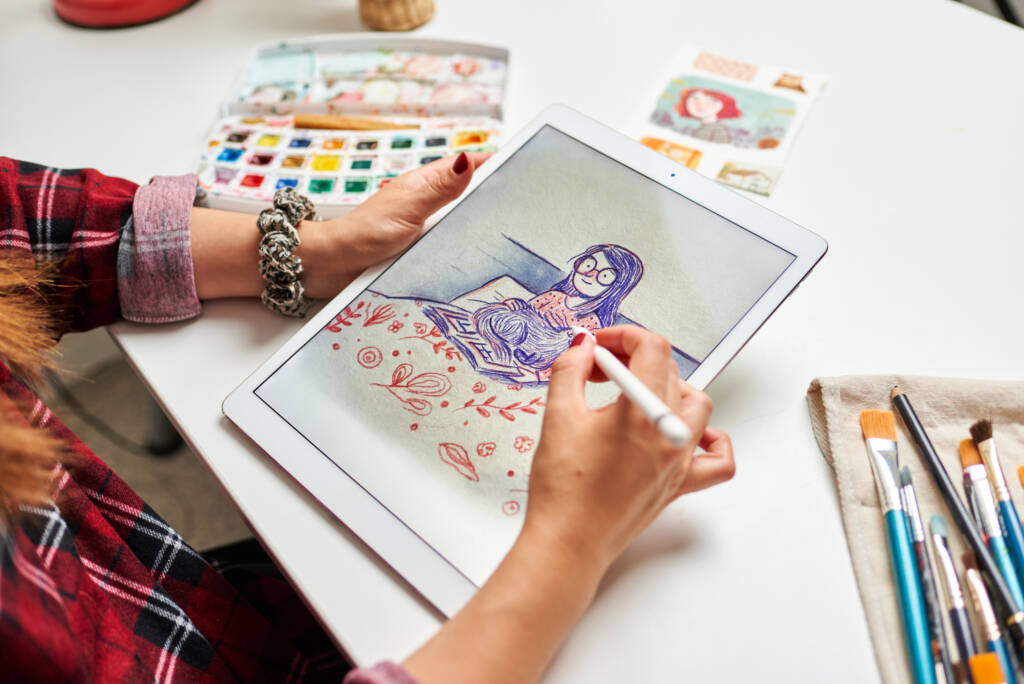Fashion Design

Are you a fashion trend follower? Are you drawn to how designers have pulled together fabrics and colors to create memorable pieces? Do you dream of designing your own line of clothing or accessories? Learn what it takes to get started in the fashion industry, from the careers available to new technology and trends reshaping the industry every day. Start creating!
Note: Access to a sewing machine is highly recommended.
During this course, you will learn career-related skills and earn a badge for this accomplishment. A badge is a digital certification of your career-related learning that you can share on social media and higher education platforms, or with colleges, potential employers, peers, and colleagues. Select this link to learn more about badges.
Major Topics and Concepts
Segment 1
Unit 1: Introduction to Fashion Careers
- Describe careers in the fashion industry
- Classify careers from entry to professional level
- Explore entrepreneurship opportunities in the design industry
- Research and present information on design careers
Unit 2: Design and Communicate: Basic Skills for the Design Industry
- Define the elements and principles of design
- Create a color wheel
- Understand the psychology of color
- Distinguish between non-assertive, assertive, and aggressive communication
- Practice active listening skills
- Explain what an informational interview is and how best to conduct one
Unit 3: Physical Tools for Fashion Designers
- Identify and select appropriate tools and equipment for a variety of projects
- Explain proper care and maintenance of equipment
- Distinguish between a variety of fabrics and explain some of their uses and qualities
- Describe how different types of software can help someone in the field of fashion design
Unit 4: Sewing 101
- Demonstrate various stitches, either by hand, on a machine, or both
- Identify the parts of a sewing machine and explain their purposes
- Select the appropriate type of stitch for a project
- Prepare fabric before sewing so that results look neat and professional
Segment 2
Unit 5: Choosing Clothing
- Explain how trends catch on, spread, and then fade
- Select appropriate clothing styles for business, casual, and formal occasions
- Describe how body type and garment fit can affect the impression an ensemble makes
- Demonstrate the procedure for recording accurate body measurements
Unit 6: The Runway Gives Back
- Explain what sustainable fashion is and why it is becoming more popular
- List the advantages and possible pitfalls of social entrepreneurship
- Describe the ways in which fashion has become more welcoming to people who have special needs or disabilities
- Identify leadership qualities to develop while giving back to the community
- Develop public relations skills when reaching out to the wider world
- Differentiate between environments with barriers and environments with barrier-free design
Unit 7: Putting It into Practice
- Define a project’s occasion, production, budget, and market
- Brainstorm ideas, select the best ones, and turn them into labeled sketches
- Create and adjust a budget based on needs and wants
- Prepare fabric and either construct or adapt a garment or accessory
- Present the completed ensemble and reflect on what you have learned
Unit 8: Entrepreneurship: Ready for Business
- Follow the rules of ethical conduct, confidentiality, and giving proper credit
- Improve skills in time management and teamwork
- Determine what to put in a resume and what to leave out
- Differentiate between types of portfolios
- Begin searching for jobs online
- Analyze modern trends in the design industry, such as 3D and 4D printing
Course Materials
Required Materials:
- Art supplies, such as paper, pens, colored pencils, paints, tape, glue, scissors, poster board, and markers
- Sewing machine (can be electronic programmable, straight stitch, zigzag, or old-style machine; should have tension adjustment controls)
- Thread
- Fabric
- Pattern
- Pattern tools to mark on fabric, such as tailor’s chalk or pen with disappearing ink
- Needle and thread for hand sewing
- Measuring tape or yardstick
- Raw materials to either create or modify a garment or accessory, such as fabric, buttons, and other components
- Video recording device
Competencies
Clothing Selection
Students will demonstrate an understanding of clothing selection by explaining fashion trends, describing clothing styles based on the occasion, and describing the impact of body type on fashion choices.
Fashion Careers
Students will demonstrate an understanding of fashion careers by describing careers in the fashion industry, differentiating entry-level and professional level fashion careers, and describing entrepreneurship opportunities in the design industry.
Fashion Design Entrepreneurship
Students will demonstrate an understanding of fashion design entrepreneurship by describing employability skills for fashion designers, describing fashion design resumes and portfolios, and analyzing the fashion design career outlook.
Sewing for Fashion Design
Students will demonstrate an understanding of sewing for fashion design by describing types of sewing stitches, explaining the parts of a sewing machine, and describing hand sewing.
Skills for the Fashion Design Industry
Students will demonstrate an understanding of skills for the fashion design industry by explaining elements of fashion design, describing the psychology of color in fashion design, and explaining positive communication skills in fashion design.
Sustainable Fashion
Students will demonstrate an understanding of sustainable fashion by explaining the fashion industry’s change towards inclusivity, describing social entrepreneurship, and describing the fashion industry’s change to the ideal of beauty.
The Application of Fashion Design Skills
Students will demonstrate an understanding of the application of fashion design skills by summarizing the steps to creating an ensemble, explaining the impact of brand recognition on fashion design, and explaining the impact of budget on fashion design.
Tools for Fashion Designers
Students will demonstrate an understanding of tools for fashion designers by describing tools for visualizing fashion designs, describing tools for producing fashion designs, and describing types of fabric for fashion designers.
